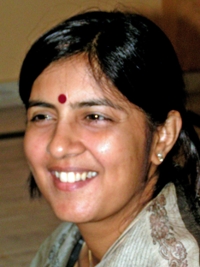While observing Jains of Los Angeles throughout my stay, I noticed they are more inclined to the ritualistic worship of the image of Tirthankaras than they are to attending the explanatory discourses. So I asked Vikash Mehta an active coordinator of the Jain Pathshala in JCSC how would the diasporic Jain, so profoundly involved in the ritualistic practices and ceremonies, respond to a movement based on the concept of vows? In response he said: "Definitely people are more engaged in ritualistic practices, but this does not mean they will not do anything else. If they find value in something else, then they will accept it."[132] He continued, "The movement is independent of any religion, and is related to everyday ethics. It can make a great impact on the Western societies."[133]
Another Jain commented in an informal conversation in Los Angeles: "The Anuvrat Movement is like the Yoga Movement; even Yoga had faced many challenges in its initial stages of expansion. Any creative program which is good for humanity will be accepted gradually by the seekers of spirituality."[134] In terms of young American Jains, the movement could possibly fill the gap for those who flinch from the ritualistic practices of their parents but would be open to a spiritual movement that gives importance to ethical living.
However, I am astounded by my findings. The Jain experts in the United States see great potential for expanding the Anuvrat Movement though few Jains in diaspora are Anuvratis. On the other hand, the Anuvratis in India are in large numbers, and have seen a rich historiography of the Anuvrat Movement (beginning with Tulsi and Mahapragya). Yet, my informants' responses convey uncertainties in the present effectiveness of the movement. Furthermore, Tulsi's distinct vision for the movement (as understood from the historical background of the movement) was to cut across the boundaries of religion, caste and sect. Despite his clear vision, my small sample reveals that the majority viewed the movement from a religious lens. Those people who view the movement as 'religious' naturally exclude the 'others.' In summation, I pose a question: Who bridges the gap between the theory and the practice?
 Shivani Bothra
Shivani Bothra
